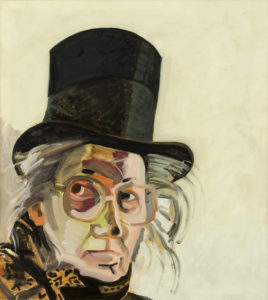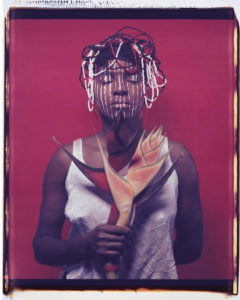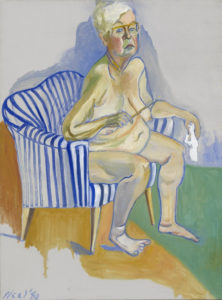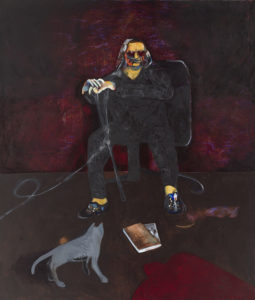The term self-conscious takes on a whole new meaning in today’s social media era.
At a time when millions of selfies are posted every day and identity is proving to be more fluid, this exhibition from the Smithsonian’s National Portrait Gallery shines a new light on self-portraiture and representation.
The show was created to commemorate the National Portrait Gallery’s 50th anniversary, celebrating the artists who make the NPG Collection so extraordinary.
Eye to I brings together the work of major artists of the 20th and 21st centuries, and kicks off its national tour at the Boca Raton Museum of Art with an indelible gallery experience sure to fascinate contemporary audiences. The powerful works are from every decade, starting in 1901 and continuing through 2015.
Eye to I: Self Portraits from the National Portrait Gallery
Kicks off National Tour in South Florida at the Boca Raton Museum of Art (March 24 – June 14)

Immerse Yourself in the Ultimate Collection of “Selfies” by America’s Leading Artists: from 1901 through 2015
The premiere in South Florida of this traveling exhibition is different from the Smithsonian show that was previously on view in Washington, DC – all of the works on paper are new and were chosen especially for the national tour, as are several of the paintings.
“These artists looked inward in ways we can connect with in our modern time. They created a lasting mirror effect for future audiences that most of them could not have foreseen,” said Irvin Lippman, the executive director of the Boca Raton
Museum of Art.

“These artists steered self-portraiture away from the traditional poses of the past into new realms of self-reflection. Their self-depictions cut across time through multiple pathways of creating art that ring true today,” adds Irvin Lippman.
Self-portraits by prominent figures in the history of portraiture include: Robert Arneson, Thomas Hart Benton, Deborah Kass, Elaine de Kooning, Alexander Calder, Jasper Johns, Allan Kaprow, Jacob Lawrence, Louise Nevelson, Irving Penn, Robert Rauschenberg, Fritz Scholder, and Roger Shimomura.
Early works include: Edward Steichen, Edward Hopper, and composer George Gershwin, who was also a painter.
More recent works include: Ana Mendieta, Chuck Close, Lois Dodd, Maria Magdalena Campos-Pons and Alison Saar.

Self-Portrait
The show was organized by the Chief Curator of the National Portrait Gallery at the Smithsonian, Dr. Brandon Brame Fortune.
She has been invited to South Florida by the Boca Raton Museum of Art to present a special preview lecture on March 24, at 5:30 p.m. Space is limited – RSVP required in advance. Tickets for non-members are $35; free for members.
(Note to Editors: a limited number of seats are available for the media, for this preview lecture. Journalists RSVP to editorial@newstravelsfast.com)
Eye to I showcases 60 works in a variety of styles and media ranging from caricatures to photographs, from colorful watercolors to dramatic paintings and time-based media.
The exhibition traces the process, from gazing into the mirror to looking into the camera; from painted and drawn surfaces to mechanical reproductions such as prints and photographs; from static forms to video.
Chosen as the cover for the exhibition catalogue, Maria Magdalena Campos-Pons used her own body to map out feelings of translocation from place to place. The bilingual title is in half-Spanish and means When I am not Here, I am There.

C/NPG.2017.122
Untitled, from the series When I am not Here, Estoy alla, by Maria Magdalena Campos-Pons. Dye diffusion transfer print (1996). National Portrait Gallery, Smithsonian Institution. Gift of Julia P. and Horacio Herzberg. © María M. Campos-Pons
She stands with her eyes closed, as though transported between territories while holding on to her Afro-Caribbean talismans.
In his sinewy Self Portrait with Rita, Thomas Hart Benton evokes the type of posturing so prevalent on Instagram today.
He was fascinated with Hollywood and channeled his inner movie star (the artist had recently seen Douglas Fairbanks in the 1924 film, The Thief of Baghdad).

NPG.75.30
Self-Portrait with Rita, by Thomas Hart Benton. Oil on canvas (c. 1924). National Portrait Gallery, Smithsonian Institution.
Gift of Mr. and Mrs. Jack H. Mooney
In 1975, Alice Neel began her shocking, endearing, and utterly unconventional self-portrait that took her five years to complete.
She foreshadowed by decades the use of “this is the real me” selfies to challenge gender and body-image stereotypes. Neel took on the history of male artists depicting nude women and flipped it around completely, with absolute control of her image.

NPG.85.19
An unflinching challenge to the centuries-old convention of idealized femininity, Neel’s self-portrait is openly accepting of her aging body.
The first thing visitors will see at the Boca Raton Museum of Art is Roger Shimomura’s monumental work, Shimomura Crossing the Delaware. The mammoth painting takes up the entire entry wall.
During World War II, Shimomura and his family were imprisoned at an internment camp, where they became familiar with the widespread xenophobia taking place at that time during the 1940s.

NPG.2012.71
Shimomura Crossing the Delaware, by Roger Shimomura. Acrylic on canvas (2010). National Portrait Gallery, Smithsonian Institution. Acquired through the generosity of Raymond L. Ocampo Jr., Sandra Oleksy Ocampo, and Robert P. Ocampo
© 2010, Roger Shimomura
In the painting, Shimomura cast himself as George Washington and replaced the Revolutionary soldiers with Samurai warriors, while a silhouette of the original painting by Emanuel Leutze haunts the background.
The exhibition aims for balanced representation of people at different points in their life journey – including death.
Self Portrait with Grey Cat was the last self-portrait by Fritz Scholder before his passing, made in 2003 when he was battling complications brought on by diabetes.

NPG.2018.2
Self Portrait with Grey Cat, 2003, by Fritz Scholder. Acrylic on canvas (2003). National Portrait Gallery, Smithsonian Institution
©2003 Estate of Fritz Scholder
The dark, moody canvas features the artist boldly facing the viewer as he leans on his cane. His eyes are covered by tinted glasses, and the tubes from his oxygen tank are visibly running from his nose to the ambiguously shadowy floor, which has been described as a reference to the “shadow of death.”
James A. Porter founded the field of African American art history. He chaired Howard University’s Art Department and directed the university’s art gallery from 1953 until his death in 1970.
He studied in France, Cuba, and Haiti and traveled in West Africa, Egypt, and Brazil. These trips abroad impacted his work, including his self- portrait which conveys the influence of Parisian artists.

James Amos Porter Self-Portrait. Oil on canvas (1957). National Portrait Gallery, Smithsonian Institution.
Gift of Dorothy Porter Wesley
“These individuals have approached self-portraiture at various points in history and using different tools, but their representations ─ especially when seen together ─ all raise important questions about self-perception and self-reflection,” said Brandon Brame Fortune, chief curator, Smithsonian’s National Portrait Gallery.
“Some artists reveal intimate details of their inner lives through self-portraiture, while others use the genre to obfuscate their private selves or invent alter egos.”

The Chief Curator of the National Portrait Gallery, Dr. Brandon Brame Fortune, has been invited to South Florida for a special appearance on March 24 at 5:30, at the Boca Raton Museum of Art. Space is limited – RSVP required in advance. Tickets are $35 (free for members of the Museum).
Eye to I: Self-Portraits from the National Portrait Gallery features a richly illustrated companion volume with an introduction by Brandon Brame Fortune and nearly 150 insightful entries on key self-portraits in the museum’s collection.
The book was published by the National Portrait Gallery in association with Hirmer Publishers, and is distributed by the University of Chicago Press.
Eye to I opens alongside the Museum’s presentation of the concurrent exhibition Edward Steichen: In Exaltation of Flowers (also on view March 24 – June 14).

In Exaltation of Flowers: Petunia, Caladium, Budleya, by Edward Jean Steichen Tempera and gold leaf on canvas
(c. 1910-1913).
The seven large Art Nouveau panels – ten feet tall each – were painted by Steichen from 1911- 1914 for the Park Avenue townhouse of Eugene Meyer and his wife Agnes but were never installed. After a number of owners, including the Museum of Modern Art, they ended up in the collection of Art Bridges.
The murals are inspired in part by Maurice Maeterlinck’s book, The Intelligence of Flowers, and depict Isadora Duncan, Mercedes de Cordoba, Katharine Rhoades, Marion Beckett and others, along with their floral counterparts.
















